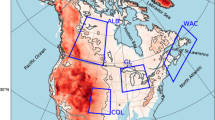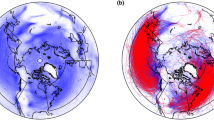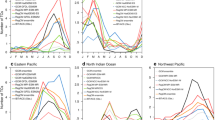Abstract
Explosive extratropical cyclones (EETCs) are rapidly intensifying low pressure systems that generate severe weather along North America’s Atlantic coast. Global climate models (GCMs) tend to simulate too few EETCs, perhaps partly due to their coarse horizontal resolution and poorly resolved moist diabatic processes. This study explores whether dynamical downscaling can reduce EETC frequency biases, and whether this affects future projections of storms along North America’s Atlantic coast. A regional climate model (CanRCM4) is forced with the CanESM2 GCM for the periods 1981 to 2000 and 2081 to 2100. EETCs are tracked from relative vorticity using an objective feature tracking algorithm. CanESM2 simulates 38% fewer EETC tracks compared to reanalysis data, which is consistent with a negative Eady growth rate bias (−0.1 day\(^{-1}\)). Downscaling CanESM2 with CanRCM4 increases EETC frequency by one third, which reduces the frequency bias to −22%, and increases maximum EETC precipitation by 22%. Anthropogenic greenhouse gas forcing is projected to decrease EETC frequency (−15%, −18%) and Eady growth rate (−0.2 day\(^{-1}\), −0.2 day\(^{-1}\)), and increase maximum EETC precipitation (46%, 52%) in CanESM2 and CanRCM4, respectively. The limited effect of dynamical downscaling on EETC frequency projections is consistent with the lack of impact on the maximum Eady growth rate. The coarse spatial resolution of GCMs presents an important limitation for simulating extreme ETCs, but Eady growth rate biases are likely just as relevant. Further bias reductions could be achieved by addressing processes that lead to an underestimation of lower tropospheric meridional temperature gradients.









Similar content being viewed by others
References
Anderson D, Hodges KI, Hoskins BJ (2003) Sensitivity of feature-based analysis methods of storm tracks to the form of background field removal. Mon Weather Rev 131(3):565–573
Arora VK, Scinocca JF, Boer GJ, Christian JR, Denman KL, Flato GM, Kharin VV, Lee WG, Merryfield WJ (2011) Carbon emission limits required to satisfy future representative concentration pathways of greenhouse gases. Geophys Res Lett 38(5):1–6
Bengtsson L, Hodges KI, Keenlyside N (2009) Will extratropical storms intensify in a warmer climate? J Clim 22(9):2276–2301
Bengtsson L, Hodges KI, Roeckner E (2006) Storm tracks and climate change. J Clim 19(15):3518–3543
Chang EKM, Guo Y, Xia X (2012) CMIP5 multimodel ensemble projection of storm track change under global warming. J Geophys Res Atmos 117(D23):1–19
Christensen J, Kumar KK, Aldrian E, An S-I, Cavalcanti I, de Castro M, Dong W, Goswami P, Hall A, Kanyanga J, Kitoh A, Kossin J, Lau NC, Renwick J, Stephenson D, Xie SP, Zhou T (2013) Climate Phenomena and their Relevance for Future Regional Climate Change. In: Climate Change 2013: The Physical Science Basis. Working Group I Contribution to the Fifth Assessment Report of the Intergovernmental Panel on Climate Change. Technical report, Groupe d’experts intergouvernemental sur l’evolution du climat/Intergovernmental Panel on Climate Change-IPCC, C/O World Meteorological Organization, 7bis Avenue de la Paix, CP 2300 CH-1211 Geneva 2 (Switzerland)
Colle BA, Booth JF, Chang EK (2015) A review of historical and future changes of extratropical cyclones and associated impacts along the us east coast. Curr Clim Change Rep 1(3):125–143
Collins M, Knutti R, Arblaster J, Dufresne JL, Fichefet T, Friedlingstein P, Gao X, Gutowski Jr. WJ, Johns T, Krinner G, Shongwe M, Tebaldi C, Weaver AJ, Wehner M (2013) Long-term Climate Change: Projections, Commitments and Irreversibility. In: Climate Change 2013: The Physical Science Basis. Working Group I Contribution to the Fifth Assessment Report of the Intergovernmental Panel on Climate Change. Technical report, Groupe d’experts intergouvernemental sur l’evolution du climat/Intergovernmental Panel on Climate Change-IPCC, C/O World Meteorological Organization, 7bis Avenue de la Paix, CP 2300 CH-1211 Geneva 2 (Switzerland)
Côté H, Grise KM, Son S-W, de Elía R, Frigon A (2015) Challenges of tracking extratropical cyclones in regional climate models. Clim Dyn 44(11–12):3101–3109
Davis CA, Emanuel KA (1991) Potential vorticity diagnostics of cyclogenesis. Mon Weather Rev 119(8):1929–1953
Dee D, Uppala S, Simmons A, Berrisford P, Poli P, Kobayashi S, Andrae U, Balmaseda M, Balsamo G, Bauer P et al (2011) The ERA-Interim reanalysis: configuration and performance of the data assimilation system. Quart J R Meteorol Soc 137(656):553–597
Denis B, Côté J, Laprise R (2002) Spectral decomposition of two-dimensional atmospheric fields on limited-area domains using the discrete cosine transform (DCT). Mon Weather Rev 130(7):1812–1829
Fink AH, Pohle S, Pinto JG, Knippertz P (2012) Diagnosing the influence of diabatic processes on the explosive deepening of extratropical cyclones. Geophys Res Lett 39(7):1–8
Froude LS, Bengtsson L, Hodges KI (2007) The predictability of extratropical storm tracks and the sensitivity of their prediction to the observing system. Mon Weather Rev 135(2):315–333
Giorgi F, Jones C, Asrar GR et al (2009) Addressing climate information needs at the regional level: the CORDEX framework. World Meteorological Organization (WMO). Bulletin 58(3):175
Haarsma R, Roberts M, Vidale P, Senior C, Bellucci A, Corti S, Fučkar N, Guemas V, von Hardenberg J, Hazeleger W et al (2016) High resolution model intercomparison project (HighResMIP). Geosci Model Dev 9:4185–4208
Hall NM, Hoskins BJ, Valdes PJ, Senior CA (1994) Storm tracks in a high-resolution GCM with doubled carbon dioxide. Quart J R Meteorol Soc 120(519):1209–1230
Hodges K (1994) A general method for tracking analysis and its application to meteorological data. Mon Weather Rev 122(11):2573–2586
Hodges K (1999) Adaptive constraints for feature tracking. Mon Weather Rev 127(6):1362–1373
Hodges K et al (1995) Feature tracking on the unit-sphere. Mon Weather Rev 123(12):3458–3465
Hoskins BJ, Valdes PJ (1990) On the existence of storm-tracks. J Atmos Sci 47(15):1854–1864
Kocin PJ, Schumacher PN, Morales RF Jr, Uccellini LW (1995) Overview of the 12–14 March 1993 superstorm. Bull Am Meteorol Soc 76(2):165–182
Lambert SJ, Fyfe JC (2006) Changes in winter cyclone frequencies and strengths simulated in enhanced greenhouse warming experiments: results from the models participating in the IPCC diagnostic exercise. Clim Dyn 26(7–8):713–728
Long Z, Perrie W, Gyakum J, Laprise R, Caya D (2009) Scenario changes in the climatology of winter midlatitude cyclone activity over eastern North America and the Northwest Atlantic. J Geophys Res Atmos 114(D112):1–13
Marciano CG, Lackmann GM, Robinson WA (2015) Changes in US East Coast cyclone dynamics with climate change. J Clim 28(2):468–484
Martin JE (2013) Mid-latitude atmospheric dynamics: a first course. John Wiley & Sons
McDonald RE (2011) Understanding the impact of climate change on Northern Hemisphere extra-tropical cyclones. Clim Dyn 37(7–8):1399–1425
Core Team R (2013) R: A Language and Environment for Statistical Computing. R Foundation for Statistical Computing, Vienna, Austria
Roebber PJ (1984) Statistical analysis and updated climatology of explosive cyclones. Mon Weather Rev 112(8):1577–1589
Sanders F, Gyakum JR (1980) Synoptic-dynamic climatology of the “bomb”. Mon Weather Rev 108(10):1589–1606
Scinocca J, Kharin V, Jiao Y, Qian M, Lazare M, Solheim L, Flato G, Biner S, Desgagne M, Dugas B (2016) Coordinated global and regional climate modeling*. J Clim 29(1):17–35
Seiler C, Zwiers F (2016a) How well do CMIP5 climate models reproduce explosive cyclones in the extratropics of the Northern Hemisphere? Clim Dyn 46(3–4):1241–1256
Seiler C, Zwiers F (2016b) How will climate change affect explosive cyclones in the extratropics of the Northern Hemisphere? Clim Dyn 46(11):3633–3644
Stull, R. B. (2000). Meteorology for scientists and engineers: a technical companion book with Ahrens’ Meteorology Today. Brooks/Cole
Taylor KE, Stouffer RJ, Meehl GA (2012) An overview of CMIP5 and the experiment design. Bull Am Meteorol Soc 93(4):485–498
Ulbrich U, Pinto J, Kupfer H, Leckebusch G, Spangehl T, Reyers M (2008) Changing Northern Hemisphere storm tracks in an ensemble of IPCC climate change simulations. J Clim 21(8):1669–1679
von Salzen K, Scinocca JF, McFarlane NA, Li J, Cole JN, Plummer D, Verseghy D, Reader MC, Ma X, Lazare M et al (2013) The Canadian fourth generation atmospheric global climate model (CanAM4). Part I: representation of physical processes. Atmos Ocean 51(1):104–125
Willison J, Robinson WA, Lackmann GM (2013) The importance of resolving mesoscale latent heating in the North Atlantic storm track. J Atmos Sci 70(7):2234–2250
Willison J, Robinson WA, Lackmann GM (2015) North Atlantic storm-track sensitivity to warming increases with model resolution. J Clim 28(11):4513–4524
Zappa G, Shaffrey LC, Hodges KI (2013a) The ability of CMIP5 models to simulate North Atlantic extratropical cyclones*. J Clim 26(15):5379–5396
Zappa G, Shaffrey LC, Hodges KI, Sansom PG, Stephenson DB (2013b) A multimodel assessment of future projections of north atlantic and european extratropical cyclones in the cmip5 climate models*. J Clim 26(16):5846–5862
Acknowledgements
The authors gratefully acknowledge the financial support of the Marine Environmental Observation Prediction and Response Network (MEOPAR) for this research. We thank Dr. Yanjun Jiao from the Canadian Centre for Climate Modelling and Analysis (CCCma) for providing us with data from CanRCM4. We acknowledge the World Climate Research Programme’s Working Group on Coupled Modelling, which is responsible for CMIP, and we thank CCCma and ECMWF for producing and making available their model output. For CMIP the U.S. Department of Energy’s Program for Climate Model Diagnosis and Intercomparison provides coordinating support and led development of software infrastructure in partnership with the Global Organization for Earth System Science Portals. We are grateful for the constructive comments from two anonymous reviewers.
Author information
Authors and Affiliations
Corresponding author
Rights and permissions
About this article
Cite this article
Seiler, C., Zwiers, F.W., Hodges, K.I. et al. How does dynamical downscaling affect model biases and future projections of explosive extratropical cyclones along North America’s Atlantic coast?. Clim Dyn 50, 677–692 (2018). https://doi.org/10.1007/s00382-017-3634-9
Received:
Accepted:
Published:
Issue Date:
DOI: https://doi.org/10.1007/s00382-017-3634-9




